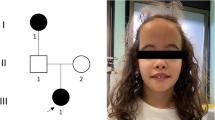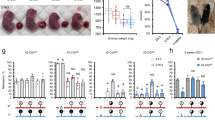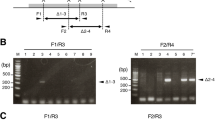Abstract
The best examples of imprinting in humans are provided by the Angelman and Prader–Willi syndromes (AS and PWS) which are associated with maternal and paternal 15q11–13 deletions, respectively, and also with paternal and maternal disomy 15. The region of the deletions has homology with a central part of mouse chromosome 7, incompletely tested for imprinting effects. Here, we report that maternal duplication for this region causes a murine imprinting effect which may correspond to PWS. Paternal duplication was not associated with any detectable effect that might correspond with AS. Gene expression studies established that Snrpn is not expressed in mice with the maternal duplication and suggest that the closely–linked Gabrb–3 locus is not subject to imprinting. Finally, an additional new imprinting effect is described.
This is a preview of subscription content, access via your institution
Access options
Subscribe to this journal
Receive 12 print issues and online access
$209.00 per year
only $17.42 per issue
Buy this article
- Purchase on Springer Link
- Instant access to full article PDF
Prices may be subject to local taxes which are calculated during checkout
Similar content being viewed by others
References
Williams, C.A. et al. Maternal origin of 15q11-13 deletions in Angelman syndrome suggests a role for genomic imprinting. Am. J. med. Genet. 35, 350–353 (1990).
Nicholls, R.D., Knoll, J.H.M., Butler, M.G., Karam, S. & Lalande, M. Genetic imprinting suggested by maternal heterodisomy in non-deletion Prader-Willi syndrome. Nature 342, 281–285 (1989).
Pembrey, M. et al. The association of Angelman's syndrome with deletions within 15q11-13. J. med. Genet. 26, 73–77 (1989).
Hamabe, J. et al. DNA deletion and its parental origin in Angelman syndrome patients. Am. J. med. Genet. 41, 64–68 (1991).
Knoll, J.H.M. et al. Angelman and Prader-Will syndromes have a common chromosome 15 deletion but differ in parental origin of the deletion. Am. J. med. Genet. 32, 285–290 (1989).
Knoll, J.H.M. et al. Chromosome 15 unipafental disomy is not frequent in Angelman syndrome. Am. J. med. Genet. 48, 16–21 (1991).
Wagstaff, J. et al. Maternal but not paternal transmission of 15q11-13 linked non deletion Angelman syndrome leads to phenotypic expression. Nature Genet. 1, 291–294 (1992).
Butler, M.G. & Palmer, C.G. Parental origin of chromosome 15 deletion in Prader-Willi syndrome. Lancet 1, 1285–86 (1983).
Mascari, M.J. et al. The frequency of uniparental disomy in Prader-Willi syndrome. New Eng. J. Med. 326, 1599–1607 (1992).
Özçelik, T. et al. Small nuclear ribonucleoprotein polypeptide N (SNRPN), an expressed gene in the Prader-Willi syndrome critical region. Nature Genet. (this issue).
Nicholls, R.D., Gottlieb, W., Avidano, K., Williams, C.A. & Driscoll, D. Mouse chromosome mapping of clones from PWS/AS genetic region. Mouse Genome 89, 254 (1991).
Chaillet, R.J., Knoll, J.H.M., Horsthemke, B. & Lalande, M. The syntenic relationship between the critical deletion region for the Prader-Willi/Angelman Syndromes and proximal mouse chromosome 7. Genomics 11, 773–776 (1991).
Wagstaff, J., Chaillet, J.R. & Lalande, M. The GABAA receptor _3 subunit gene: characterization of a human cDNA from chromosome 15q11q13 and mapping to a region of conserved synteny on mouse chromosome 7. Genomics 11, 1071–1078 (1991).
Cattanach, B.M. Chromosome imprinting and its significance for mammalian development. Genome Analysis 2, 41–71 (1991).
Searle, A.G. & Beechey, C.V. Genome imprinting phenomena on mouse chromosome 7. Genet. Res. 56, 237–244 (1990).
DeChiara, T.M., Robertson, E.J. & Efstratiadis, A. Parental imprinting of the mouse Insulin-like growth factor II gene. Cell 64, 849–859 (1991).
Ferguson-Smith, A.C., Cattanach, B.M., Barton, S.C., Beechey, C.V. & Surani, M.A. Embryological and molecular investigations of parental imprinting on mouse chromosome 7. Nature 351, 667–670 (1991).
Bartolomei, M.S., Zemel, S. & Tilghman, S.M. Parental imprinting of the mouse H19 gene. Nature 351, 153–155 (1991).
Zemel, S., Bartolomei, M.S. & Tilghman, S.M. Physical linkage of two mammalian imprinted genes, H19 and Insulin-like growth factor 2. Nature Genetics 2, 61–65 (1992).
Williams, C.A., Gray, B.A., Hendrickson, J.E., Stone, J.W. & Cantu, E.S. Incidence of 15q deletions in the Angelman syndrome: A survey of 12 affected persons. Am. J. med. Genet. 32, 339–345 (1989).
Magenis, R. E. et al. Comparison of the 15q deletions in Prader-Willi and Angelman syndromes: specific regions, extent of deletions, parental origin and clinical consequence. Am. J. med. Genet. 35, 333–349 (1990).
Cassidy, S.B. & Ledbetter, D.H. Prader-Willi syndrome. Neurology Clinics 7, 37–54 (1989).
Butler, M.G. Prader-Willi syndrome: current understanding of cause and diagnosis. Am. J. med. Genet. 35, 319–332 (1990).
Searle, A.G. & Beechey, C.V. Non-complementation phenomena and their bearing on non-disjunctional effects. In: Aneuploidy (Ed V.L. Dellaraco, P.E. Voytek, & A. Hollaender 363–376) (Plenum Press Inc. 1985).
Cattanach, B.M. A chemically-induced variegated-type position effect in the mouse. Z. Vererbungsl 92, 165–182 (1961).
Leff, S.E. et al. Maternal imprinting of the mouse Snrpn gene and conserved linkage homology with Prader-Willi syndrome region of humans. Nature Genet. (this issue).
Forejt, J. & Gregorová, S. Genetic analysis of genomic imprinting: An imprintor-1 gene controls inactivation of the paternal copy of the mouse Tme locus. Cell 70, 443–450 (1992).
Barlow, D.P., Stöger, R., Herrmann, B.G., Saito, K. & Schweifer, N. The mouse insulin-like growth factor type 2 receptor is imprinted and closely linked to the Tme locus. Nature 349, 84–87 (1991).
Bartolomei, M.S. & Tilghman, S.M. Parental imprinting of mouse chromosome 7. Semin. devel. Biol. 3, 107–117 (1992).
Moore, T. & Haig, D. Genomic imprinting in mammalian development: a parental tug of war. Trends Genet. 7, 45–49 (1991).
Evans, E.P. T(7;15)9H, correction of breakpoint. Mouse Genome 90, 210 (1990).
Evans, E.P. T(7;18)50H. Refinement of breakpoints. Mouse Genome 89, 551 (1991).
Chomczynski, P. & Sacchi, N. Single step method of RNA isolation by acid guanidium thiocyanate-phenol-chloroform extraction. Anal. Biochem. 162, 156–159 (1987).
Maniatis, T., Fritsch, E.F. & Sambrook, J. (eds) Molecular cloning: A laboratory manual, Cold Spring Harbor, NY (1982).
Minty, A.J., Alonso, S., Caravatti, M. & Buckingham, M.E. A fetal skeletal muscle actin mRNA in the mouse and it's identity with cardiac actin mRNA. Cell 30, 185–192 (1982).
Church, G.M. & Gilbert, W. Genomic Sequencing Proc. natn. Acad. Sci. U.S.A. 81, 1991–1995 (1984).
Wagstaff, J. et al. Localisation of the gene encoding the GABAA receptor _3 subunit to the AS/PWS region of human chromosome 15. Am. J. hum. Genet. 49, 330–337 (1991).
Mitchell, M.J., Woods, D.R., Tucker, P.K., Opp, J.S. & Bishop, C.E. Homology of a candidate spermatogenic gene from the mouse Y chromosome to the ubiquitin-activating enzyme E1. Nature 354, 483–486 (1991).
Author information
Authors and Affiliations
Rights and permissions
About this article
Cite this article
Cattanach, B., Barr, J., Evans, E. et al. A candidate mouse model for Prader–Willi syndrome which shows an absence of Snrpn expression. Nat Genet 2, 270–274 (1992). https://doi.org/10.1038/ng1292-270
Received:
Accepted:
Issue Date:
DOI: https://doi.org/10.1038/ng1292-270
This article is cited by
-
Small nuclear ribonucleoprotein polypeptide N (Sm51) promotes osteogenic differentiation of bone marrow mesenchymal stem cells by regulating Runx2
Cell and Tissue Research (2016)
-
Recommendations for the investigation of animal models of Prader–Willi syndrome
Mammalian Genome (2013)
-
Le syndrome de Prader-Willi
Obésité (2011)
-
Animal models of human genetic diseases: do they need to be faithful to be useful?
Molecular Genetics and Genomics (2011)
-
Prader-Willi and snoRNAs
Nature Genetics (2008)



